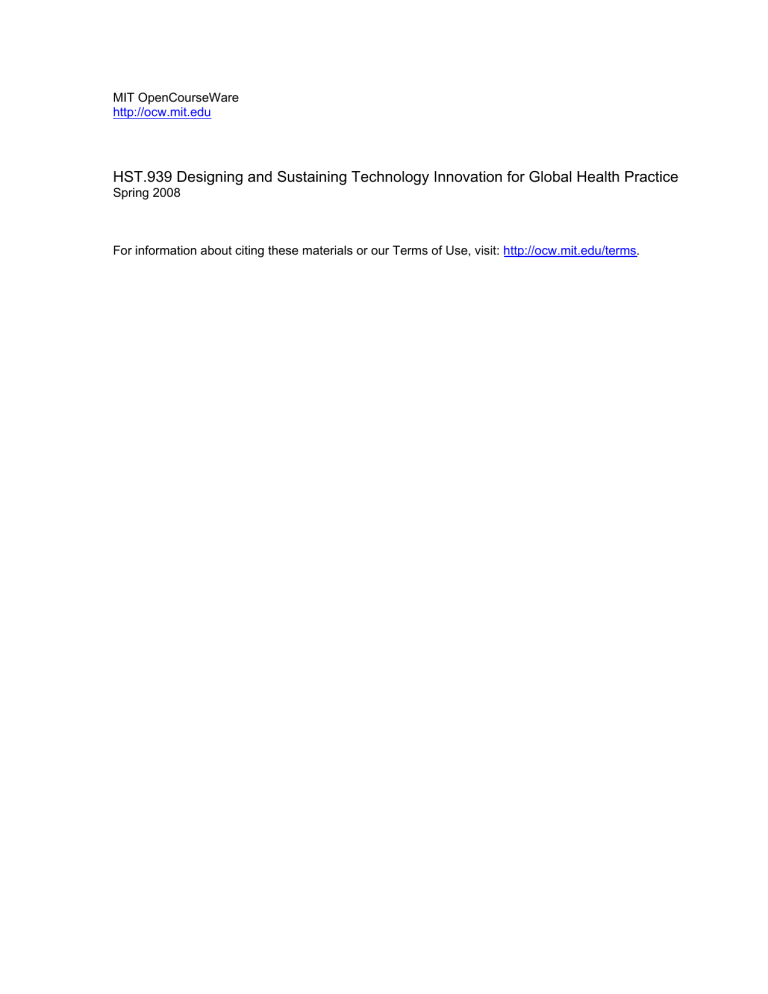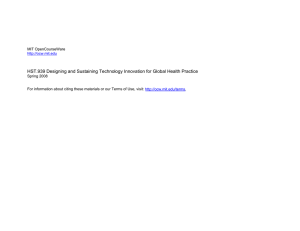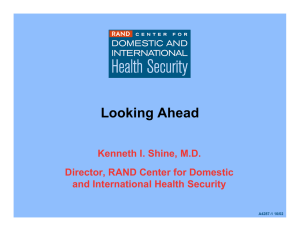HST.939 Designing and Sustaining Technology Innovation for Global Health Practice
advertisement

MIT OpenCourseWare http://ocw.mit.edu HST.939 Designing and Sustaining Technology Innovation for Global Health Practice Spring 2008 For information about citing these materials or our Terms of Use, visit: http://ocw.mit.edu/terms. HST.939 Designing and Sustaining Technology Innovation for Global Health Practice Spring 2008 Notes taken for OCW by student Lecture 2: 2/12/08 HPV vaccine case study PATH: www.path.org - Mission: to improve the health of people around the world by advancing technologies, strengthening systems, and encouraging healthy behaviors - Present to some extent on all continents - About 50% of work is vaccine-related in some way Developing technologies to support vaccines and immunizations: - cold chain equipment - jet injectors - novel syringes - packaging - vaccine stabilization New vaccine development: - malaria vaccine initiative - meningitis vaccine project - pneumococcal - new rotavirus vaccines - enteric vaccine initiative (ETEC) - new influenza vaccines These are all done in partnership with private labs. Malaria vaccine: - pipeline is largely early stage - RTS,S/AS02A Clinical Trial children: o Phase 2b trials in Africa showed RTS,S: delays in time to new infections of P. falciparum by 45%; reduces risk of new episodes by 30%; PATH is also promotinv broad-based malaria prevention programs - Vaccines won’t be able to fully deal with the malaria problem - Insectide-treated nets; indoor residual spraying; malaria in pregnancy; better antimalarials Cervical cancer: - major health problem in developing world - huge inequities between impact on women in developed vs. developing world - afflicted women in developing countries are stigmatized and isolated - everyone has a right to be screened at least once; it’s most effective to screen and treat in one visit, because o but we need a more effective, affordable screening test o fast, affordable accurate HPV tests are on the horizon (e.g. START) - New promise of HPV vaccines; two now available; provide excellent protection against HPV 16 and 18 (responsible for 70% of cervical cancers worldwide) Sample research questions: - how to motivate parents and teens for vaccinations? - Community-based and/or school-based delivery? - Best age for max coverage? - Alternative dose schedules? - Additional health interventions to be provided? - Lessons for eventual HIV vaccine introduction? Schools offer a promising venue in most regions. Completion of primary school by girls is high in many regions and is increasing rapidly. Lack of education or understanding about cervical cancer. Financing is a real challenge; what seems like very little money to us is a nearly impossible cost for people in developing countries. Main funding mechanism is GAVI (Global Alliance for Vaccines International) – billions of dollars. 98% project-specific funding How does PATH figure out what to work on? - combination between strategic thinking (“what are the most statistically important/devastating problems?”) and between what their benefactors will fund. Funders are beginning to act more strategically as well, though. Discussion of projects; procedure; summaries of the mentors’ various projects - each project will focus on two “tracks”, or types of work Cliff Tabin: develop algorithms to help non-doctors diagnose people in the field Jose Gomez-Marquez: working on inhalation of vaccines; project to design clinical trial for use in other countries that follows FDA guidelines, but accelerated - also has a project related to improving TB treatment adherence; develop a product development strategy based on what is likely to work amongst the population Ben Bauman: open source technology, OpenClinica, designs clinical trials for use in developing countries And so forth; see the following Project List table. Project List Title Contact Organization Country Area of Interest Project Description 1.Use of Algorithms for Training and Practice of Midlevel Health Care Workers Cliff Tabin Nick Simons Institute Nepal Medical Informatics, Medical School development We are looking at the use of clinical algorithms as part of the teaching / learning process. Algorithms have been reportedly used to train lower and mid level health care workers in many parts of the developing world. In Nepal, the use of algorithms is very new and has only been used in a limited role. 2.Design a clinical Jose Gomeztrial in a host Marquez country following FDA guidelines for inhalation devices. Aerovax Open Device manufacturing, vaccines Our goal is to increase immunization yields in remote populations and post-disaster sites. Our inhalation platform has been able to replicate and exceed the performance of hospital based inhalation devices. 3.Designing Ben Baumann Methods for Collection of Field Research and Data Transfer in Resource Poor Settings Akaza Tanzania Medical Informatics, Operations Research OpenClinica is an open source software product for managing clinical research studies. Its open source nature of provides a unique level of flexibility and makes highquality, enterprise-quality clinical software accessible to research organizations around the world. 4.Improving TB Adherence Jose GomezMarquez, Elizabeth Gillenwater X out TB Nicaragua Adherence, mobile Develop a Product Development Strategy for the X out devices, TB, TB Program Using Country Appropriate Incentives. Our surveillance goal is to increase patient adherence to TB drug regimes. Our solution, X out TB, is a combination of customized incentives with a novel remote-monitoring program that both encourages and facilitates adherence. 5.Rapid CD4 Business Plan Uktan Demirci, BAMM Laboratories, Jeffrey Blander Muhimbili National Hospital Tanzania Diagnostics, Create a business plan and clinical study for the first time Microfluidics, HIV rollout of a rapid CD4 test for PLWHA Title Contact Organization 6.NCD Strategy for Jeffrey Blander, Bienmoyo, Brigita Diabetes Dr. Rainer Dispensary management Country Tanzania Area of Interest Diabetes, NCD Project Description Support the development of a cost effectiveness study comparing local disease management methods to conventional insulin regimen for type II diabetes management. 7.Health Care Revolving Fund Jeff Blander, Dr Bienmoyo/APHFTA Kaushik Tanzania Microfinance, Public Private Partnerships Support the development of a revolving fund to support the private hospital and faith based facilities organizations in Tanzania. These organizations are responsible for 54% or all health care in Tanzania. 8.Female led franchising of sanitary napkins Elizabeth Scharpf Sustainable Health Ventures Open Women's Health, Social entrepreneurship Sustainable Health Ventures (SHV) aims to unleash girls' economic potential by starting up female-run franchises that manufacture and distribute low priced, high-quality, and environmentally friendly sanitary towels for domestic and international consumption. 9.Strategies to Julia Nicole Reduce Pollution Tatum from Charcoal Production in Egypt N/A Open Clean Energy Charcoal is one of the most important and commonly used fuel sources in the developing world. There is a great need to develop a charcoal production process which is less polluting than current methods but economically feasible. 10.Development of Pam Frank Global Health resource databank GlobalHealthMap.Org Open Academic Health Centers, Medical Experts The Global Health Map (GHM) is a non profit 501c3 that helps internationally oriented US hospitals and clinicians to promote their global work, to fundraise for their projects and to come together as a community for the aggregation and dissemination of information and resources. Homeless, Insurance, Emergency Medicine Support the cost effectiveness and patient flow analysis of tailored medical services for the homeless to avoiding unnecessary use of emergency room admissions for routine care visits. 11.Improving James O'Connell Partners, Health Care for USA health systems for the Homeless Initiative the homeless Title Contact 12.Rapid Tests for Charles F. Breast Cancer Streckfus Screening Area of Interest Breast Cancer, Rapid Test Project Description Develop global business plan for rapid test in developing world for screening breast cancer. The product is based upon protein-by-products secondary to cancer related oncogenes that are over or under expressed that appear in the saliva of breast cancer patients. 13.Mental Health Aldofina Bienmoyo/MEHATA, Tanzania Services for Rural Regional Mental Office of The Regional Poor Women Health Medical Officer of Lindi Coordiantor, Jeff Blander Mental Health Support the integration of mental health in primary care in Lindi. Currently mental health services are not formally provided, yet the burden of illness and service need to considered to be over 5% of all clients in the region. 14.Cardiac Care Services for Mainland China China Cardiology To decrease CVD mortality and to create an approach to decreasing CVD risk factors that will be scalable, first in Chinese communities nationwide, and second to other developing countries facing similar obstacles to addressing CVD. 15.Health Care Dr. Issac, Jeffrey Bienmoyo/The Access to Orphan Blander Ambassadors Children Tanzania Orphans, Homeless,Establishing a sustainable association that will provide Social Services. health care services to 55 Orphanages in Dar Es Salaam City. 16.Newborn Rescue Cot Liberia Medical Device, Pediatrics, Newborn resuscitation Anna Chodos Marci Brooks Organization Country CCTS Proteomics Core Open UTHSC - Dental Branch Unite for Health Impact Pediatrics International Impact Pediatrics International is an emerging nonprofit organization focused on improving the health of infants and children living in global resource-limited settings. Impact has created a new medical device for newborn resuscitation in resource-poor settings. Title 17. Neglected of Neglected Contact Organization Blander/ Gomez - HST939 Marquez Country TBD Area of Interest Product design, access to care, policy, Cancer (chemo therapy, XRAY), ESRD (dialysis) Project Description Each year millions of persons living in resource poor settings suffer from non communicable diseases. Currently there are western technologies available that include pharmaceuticals and diagnostic equipment for cancer and ESRD. However these supplies are too expensive and access is limited. This project will focus on the intersection of corporate policy, procurement, and human resources in health to uncover solutions and road blocks to cancer and ESRD management. 18. Sherlock Holmes: Orphan Drug Act implications for 21st Century Blander/ Gomez - HST939 Marquez USA Policy, drug The advent of Orphan Drug Act in the United States discovery, TRIPS spurned a large increases in drug development efforts for diseases targeted at populations less than 350,000. However little is known about the story behind the passage of the orphan drug act and even less about the many parallels that face the current neglected diseases for the developing world. 19. Bodas for Life Ali Bloch Project Blum Center For Uganda Developing Economies – UC Berkeley Ambulances, human resources for health, health services. The expansion of wireless networks to rural areas brings with it the potential to dramatically upgrade rural healthcare. Help to support the evaluation and scale ability of pilot efforts in Nakaseke District of Uganda, in partnership with the Ugandan Ministry of Health and Mbarara University, in which incentivized boda boda drivers took patients to health centers and hospitals 20. Disease Nadine Semer Management Software for NCD WorkMovR Disease management, software, NCD The WorkMovR Software Company has developed an innovative business management software product which can be tailored into a chronic disease management tool. This project will examine this product in the context of delivering supportive TBD Title 21. Portable surgical kit Contact Christina Kang Organization HST939 Country TBD Area of Interest Project Description Surgery, emergency Surgical and other body-invasive procedures are difficult medicine. to perform in developing nations due to a lack of sterilized equipment and sterilized space. The goal is to create a new medical device that creates a portable, sterile surgical environment to perform emergency procedures. This can apply to war scenes as well.




